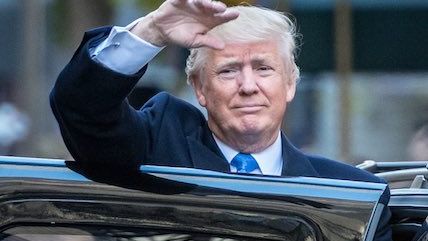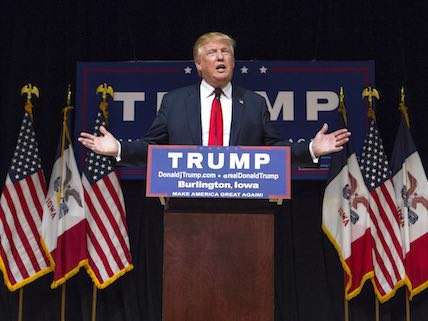The Southern Poverty Law Center Has Little Authority to Claim Trump Has Driven Up School Bullying Rates
Trump is definitely a bully, but are things really that bad in American schools?


Donald Trump's xenophobic, hate-filled campaign has undone years of progress on reducing bullying in schools, according to The Nation's Katherine Stewart.
"The damage to our school culture is already evident," she writes. "Schools have invested years in anti-bullying programs, and a lot of that progress has been undone in a few short months. The damage to our political culture will likely be even greater, and take longer to repair."
That's a strong claim, since school anti-bullying initiatives have successfully driven down bullying rates in recent years. According to the National Center for Education Statistics, the bullying rate fell from 28 percent to 22 percent between 2011 and 2013, the most recent year for which data is available. We don't know what the rate looks like in 2016, but Stewart appears confident it would be higher, and Trump is the cause.
Of course, we don't really have any evidence of that, aside from anecdotes. Stewart cites a number of examples of teachers reporting truly horrific things—kids asking whether it's okay to burn Jews, for example—and concludes that Trump's rhetoric is responsible for an overall surge in race-based attacks on minority students. This is a plausible assumption: Trump's policies are harmful to immigrants, and his followers do say racist things. (Go on Twitter and pick a fight with a member of the alt-right if you don't believe me.) But has it made the overall school environment noticeably more hostile? It's possible, but in lieu of relevant of data, I'm skeptical.
After all, it's not so long ago that schoolyard brawls were commonplace—now these students are dealt with harshly, often by cops stationed in schools. When I was in school (the 90's and 00's), anyone even suspected of being gay was horribly bullied. Now schools have gay-straight alliances, sympathetic counselors and other programs aimed at encouraging acceptance. I'm sure there's a lot more work to be done on this front, but it seems undeniable that the education system is a whole lot friendlier to LGBTQ kids. And bullying is actually defined much more broadly these days—miscreant students can get away with less.
Does the so-called "Trump effect" invalidate the progress on those and other fronts? Here's author Mica Pollock in The Washington Post:
The National Education Association has been sharing teachers' stories of anti-immigrant, anti-Muslim, and bullying talk on the rise as students cite and extend Trump's rhetoric. Fall incidents include homemade "white pride" Trump T-shirts at high school homecoming; increasing incidents of Muslim students bullied on buses and in classrooms; and even explicit "Nazi" talk among students. And students are now hearing Trump supporters threaten armed rebellion if he doesn't win.
"Trump Talk" has unleashed a wave of explicit hate and intimidation for educators to address. And to have a presidential candidate unleash such talk — especially without reproach from many powerful politicians — sets an extremely confusing example.
That's because schools are places where hate speech, harassment and encouragement of violence are supposed to be challenged.
Challenged is different than censored, however—a distinction Pollock only sort of makes:
In schools, students are taught not to bully other people. And there are actual laws saying schools can't just let hateful and violent speech go. As a professor colleague put it, "Trump speech on public campuses creates a very real tension between the civil liberty of speech and the civil right not to be intimidated."
Civil-rights lawyer friends have clarified for me that any campus receiving federal funds has to debate a key issue in the era of Trump. When does speech — even speech protected under the First Amendment — produce a hostile environment, prohibited by federal and state civil-rights laws? Such laws forbid educators in federally funded public schools from tolerating or allowing an education environment in which harassment based on race, color or national origin (or sex, or disability) is "sufficiently severe, pervasive, or persistent so as to interfere with or limit a student's ability to participate in or benefit from the services, activities, or opportunities offered by a school."
First, there's a huge difference between K-12 and college. Courts have given elementary, middle, and high schools much more leeway to prohibit offensive speech on the grounds that it is disruptive. Public university students, on the other hand, enjoy robust First Amendment protections. Laws prohibiting hostile educational environments do not supersede the Constitution, and administrators must be very careful not to conflate unconstitutional harassment with "hate" speech. Hate speech is not a category of prohibited expression.
Second, it's incredibly self-serving for Hillary Clinton's closest political allies—including the National Education Association—to argue that her opponent has worsened the school bullying problem. The closest thing to actual data in support of this position is a survey produced by the Southern Poverty Law Center. But, as I wrote recently, this survey is unscientific, and the SPLC has a history of making unfair accusations against people who aren't particularly hateful but are nevertheless political enemies. In fact, the SPLC recently included Ayaan Hirsi Ali and Maajid Nawaz on its list of "Anti-Muslim Extremists"—a list that makes no distinction between liberal critics of Islamic jihadism and Pamella Geller.
I don't think the SPLC is a particularly reliable arbiter of extremism, in other words.
As for teachers unions, keep in mind that they engage in bullying behavior all the time.
Trump is certainly a bully, and his toxic campaign could be making life worse for immigrant and minority children, which is a shame. But we haven't seen any data on that yet, and we should be wary of liberal political activists trying to turn this to their advantage. Clinton has already vowed $500 million in spending on new anti-bullying initiatives to combat this latest scourge of hate, but we don't know whether these solutions will be effective. We don't even properly understand the scope of the problem, despite what the SPLC, teachers unions, and their media allies claim.


Show Comments (28)